When the first few stalks of paddy —still edged with green and pulsing with new life —have been ritually harvested, tied around a stone pillar in the central courtyard, and hung over a glowing lamp in the heart of an ancestral home which has probably stood in the same place for 150 years or longer, the celebrations begin. With all the singing and dancing that goes on, there’s always a feast around the corner. The countryside is luminous at this time of year: a certain deepening of its beauty brought on by ripples of ripe grain standing in the fields, an abundance of produce, and a rare tranquillity.
But this is Coorg. The lamplight and home fires must always be edged around by something a little darker, something wild, with a hint of old forests and long hunting days: even if hunting now rests in stories of the past, a past that stretches away endlessly beyond the limits of the imagination and brings back timeless images of “the pork and brandy feasts” of puthari, the harvest festival.
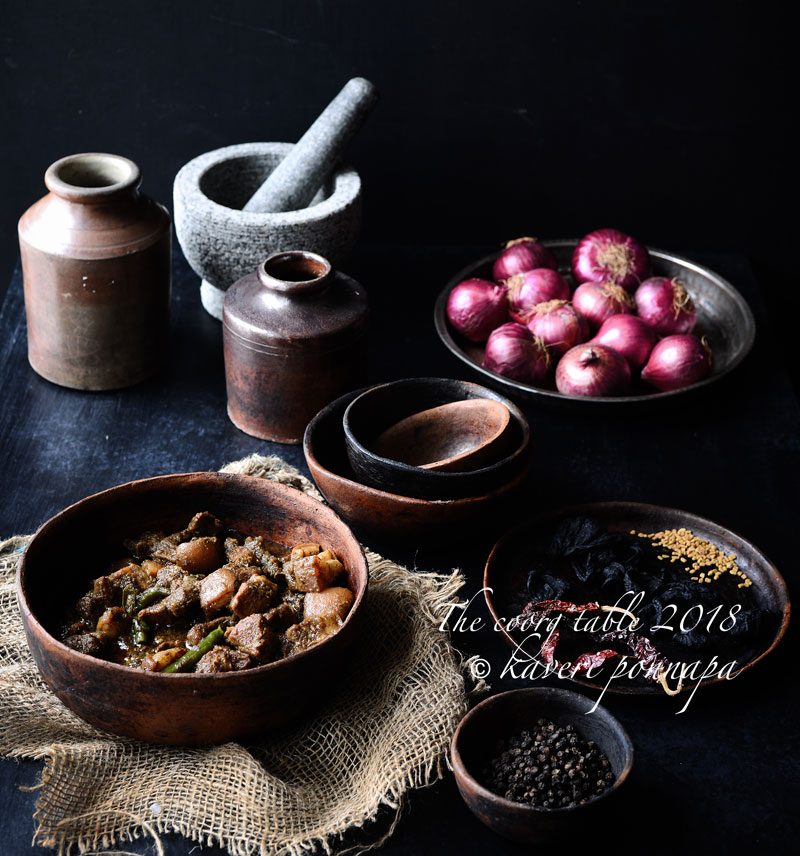
At puthari, the rice fields are covered with a wash of silver by night, and golden green by day. A fragile sheen of past celebrations blots out, for a while, the crush of tourists, crowded towns, the traffic jams. The Coorgs retreat to their homes, fields and ancestral strongholds to harvest, feast, sing and dance. Quite often, driving along a road deep in the countryside, you catch a glimpse of a group of men with small drums, singing, followed by a trailing crowd, disappearing down a quite lane. They sing the histories of the clans, walking from one ancestral home to the next. It’s a beautiful way of remembering: waking up slumbering old houses, and singing people into forgotten frameworks. The community hunt, once so much a part of these celebrations is gone; hunting parties no longer comb the forests in pursuit of wild boar, preferred, as recorded by early visitors to the land, by the Coorgs to all other meat. But true to tradition, pork features at the puthari feast.
We smoke, dry, preserve, curry, braise, fry and roast pork, extracting every ounce of flavour, varying the texture as much as we can, sometimes scooping a spoonful of preserved pork fat from a ceramic jar into a dish, intensifying flavours. At the big village feasts and celebrations, besides the barbequed pork, there is always a deep, rich, pandi curry.
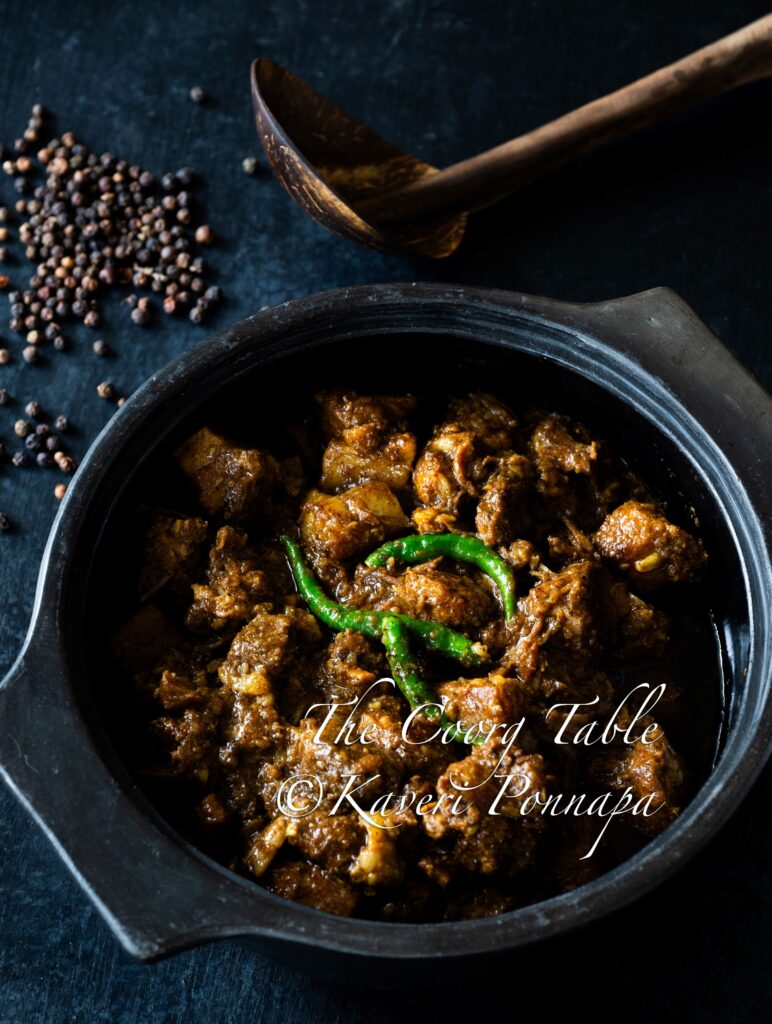
There are probably as many versions of this ancient dish, born out of our hunting past, as there are kitchens. I have my own favourites, tasted at various tables and feasts.
Food changes with the ingredients available at hand; but sometimes one comes across a dish that has evolved so perfectly in its own time and place that it is best left alone. A modern touch that jars is the incongruous garnish of coriander leaves. And a heavy hand with spices and kachampuli. The personal benchmark for pandi curry came to me from a set of proportions for dry spices I wrote down in a journal more than three decades ago. It has travelled with me across countries and continents; every mouthful takes me back to Coorg, to that particular collective history —of forests, and a coming together of culture and spices from where this curry emerged.
If you cook it, you should get is something like this: cubed chunks of tender pork in a dense, molten gravy, releasing the slow heat of black peppercorns, grown in the hills of Coorg since the times when wild vines could be seen looping across trees, sketching great arcs and webs across the dense jungles. Red chillies were latecomers: even the violent little bird’s eyes, referred to locally as parangi, betray their foreign origins. Hidden notes from dark roasted spices that have survived a pounding in a mortar and pestle, and have begun to release their flavours into the pork should follow the heat of the roasted peppercorns. A sharp burst of kachampuli —that’s all you need—to slice through the gleam of melted fat. You may like a squeeze of lime, just for its exuberant freshness, before you tuck into a plateful. If you happen to have a wood fire in your kitchen, and the patience to slowly meld all its flavours into one, harmonious whole: fierce, crushed ginger; a touch of golden sesame oil; all those dark spices, and rendered fat, it’s unlikely that you will ever forget the taste. It is as perfect a dish that ever came out of an extraordinary place.
Read more about Pandi Curry here: Pork Tales.
Pandi Curry Recipe ( Slow Cooked & Pressure Cooked Recipe )
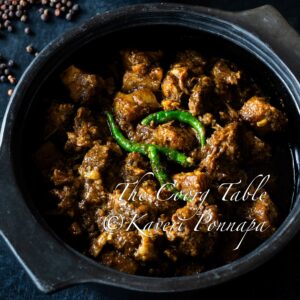
Slow Cooked Pandi Curry Recipe
Equipment
- 1 Kadhai(cooking pot) for cooking the pork with spices
- 1 Cast iron pan or Frying pan for roasting the spices
- 1 Grinder to grind the cumin and mustard seeds
Ingredients
- 1 kg Pork with skin and fat Cut into small pieces.
- Salt as per taste
- 1 tsp Fresh ground pepper powder
- 1 tsp Turmeric powder
- 2 tbsp Chilli powder ,use level tablespoon, not heap.
- 3 tbsp Coriander powder ,use level tablespoon, not heap.
- 3 tbsp Gingelly oil ,a bit more, if the pork has very less fat.
- 6 medium Onions ,sliced.
- 1 pod Garlic ,coarsely crushed.
- 2 inch Ginger ,crushed.
- 1 ½ tbsp Kachampuli (Coorg Vinegar) ,if you dont have Kachampuli, you can add Malt Vinegar.
Dry Spice Mix
- 1 tbsp Cumin Seeds (Jeera) ,slow roasted on a tava(frying pan), until medium brown, cooled & powdered fine.
- ½ tbsp Mustard seeds ,slow roasted on a tava(frying pan), until medium brown, cooled & powdered fine.
Instructions
- Wash the pork, (retain ½ cup water) drain, and add 1 tsp salt, 1 tsp pepper powder, turmeric and set aside.
- Mix the sliced onions & crushed garlic with the pork.
- Heat about 3 tbsp gingelly oil (more, if the pork contains less fat), add the crushed ginger, & fry until brown. Remove browned ginger, & add to the pork.
- On very low flame, add 3 level tbsp coriander powder & keep stirring for about 1 minute. Then add 2 level tbsp chili powder, & stir until it turns coffee brown.
- Add the pork, & its washed water (about ½ cup). Cover the vessel with a lid, & cook on medium flame until all the water evaporates. Keep stirring occasionally.
- When all the water has evaporated, add warm water to just cover the meat, and cook uncovered on a medium flame until done.
- Once the pork is done, whether slow cooked, or pressure-cooked, add 1 ½ tbsp kachampuli, stir, & cook for a further 10 mins on a slow fire. Taste, & add more salt or kachampuli, as required. The oil should rise to the surface.
- Add the roasted, ground jeera and mustard seeds to the curry, stir and simmer for a few minutes before turning off the heat.
Notes
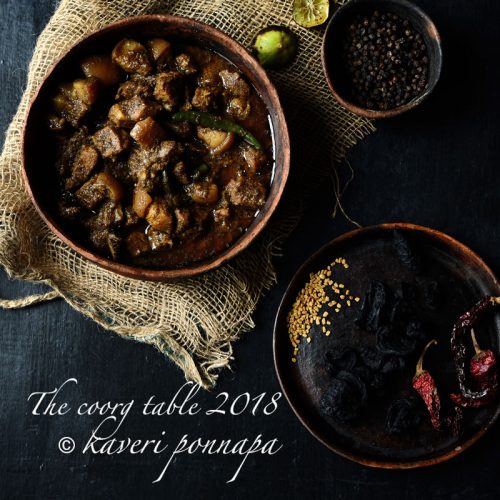
Pandi Curry - Pressure Cooker Recipe
Equipment
- 1 Cast iron pan or Frying pan for roasting the spices
- 1 Grinder for grinding the dry spices
- 1 Pressure Cooker
Ingredients
For the Spice mix:
- 1 tbsp Black peppercorns or more, according to taste
- 1 tbsp Cumin seeds
- 1 ½ tbsp Coriander seeds
- 1 ½ tbsp Mustard seeds
- 1 tsp Fenugreek seeds scantly
- 1 tsp Cassia bark optional
- ½ tsp Cardamom optional
- ½ tsp Cloves optional
For the Curry
- 1 Kg Pork A combination of lean meat, fat and bone, cut into approximately 1-inch cubes
- 1 tsp Turmeric powder
- Red Chilli Powder to taste optional
- 3 Large Onions
- 3 Inch Root Ginger scraped
- 1 ½ Bulbs Garlic peeled
- 2-3 Full Fresh Green Chilies slit
- 3-4 tbsp Sesame oil
- Salt to taste
- 2 Cups Hot water
- 1 Level tbsp Kachampuli (Coorg Vinegar)
Instructions
- Dry roast each of the above whole spices separately, cool and grind to a powder in a mortar and pestle or spice grinder.
- Wash the pork, pat dry. Sprinkle with turmeric powder, and red chilli powder if using, Mix well, and set aside.
- Chop the onions finely. Scrape the ginger, peel the garlic, and grind together to a smooth paste in a food processor. Slit the green chilies and set aside.
- Heat the sesame oil in a pressure cooker, and when hot, add the chopped onions. Stir and fry over medium heat until translucent. Add the ginger-garlic paste, and fry until the raw smell disappears.
- Add the marinated pork cubes, raise the heat and fry until the meat changes colour.
- Now reduce the heat, add the dry-roasted spices, and mix until the cubes of pork are well coated with the spice mixture. Add salt to taste, 2 cups hot water (more or less, according to the thickness of gravy you prefer) and bring to a boil over medium heat. Cover, reduce the heat to low-medium, and pressure cook for about 20 minutes.
- Remove from the heat. Allow the pressure to drop. Test for doneness. The pork should be tender but firm.
- Return to the heat, toss in the slit green chillies, add the Kachampuli, and simmer for about 5-7 minutes over low heat before turning off the heat.
Notes
Pandi curry is usually eaten with Akki Ottis or Kadambuttus.
All Food Styling: Kaveri Ponnapa
Photo Credits: A.G.P Sathyaprakash
Do look out for the recipes of all the food featured here in my upcoming cookbook.
Thank you for visiting this page. If you read something that you enjoy, or see an image that you like, please take a moment to write a response.

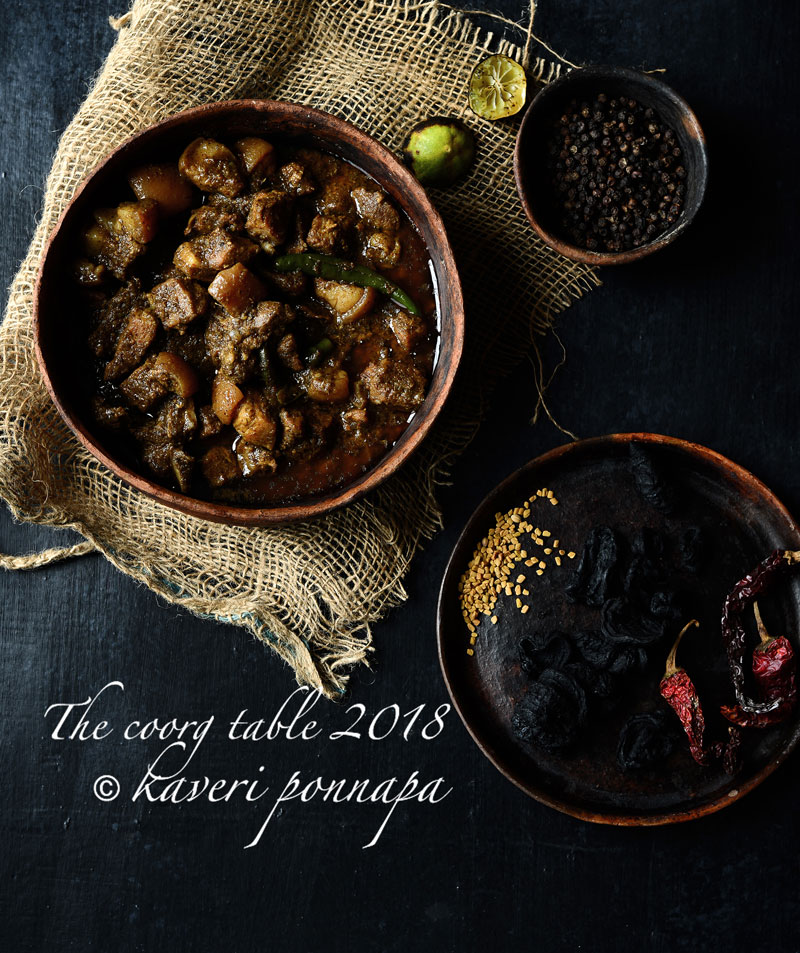
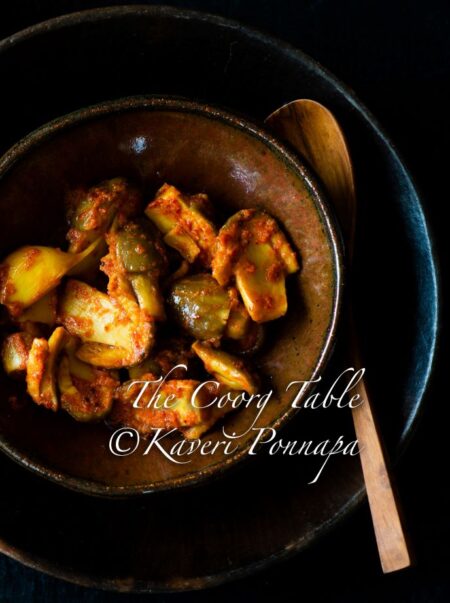
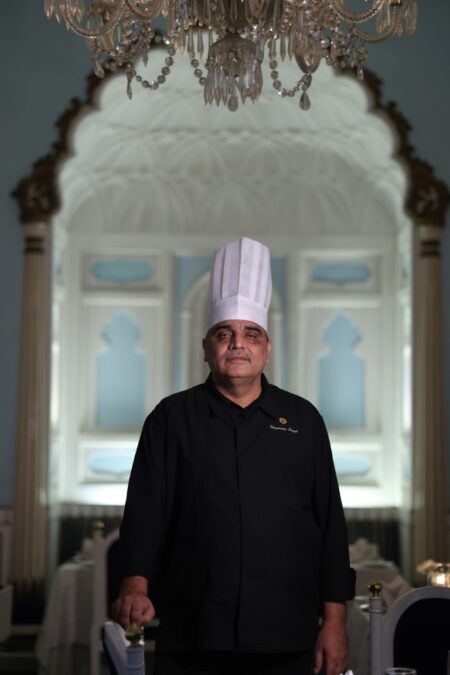

So Happy to get authentic Recepies. Love the Cusine and Hospitality. All the best. Congratulations
Hi Deepika, so glad to hear from you. This is my recipe for the most popular Pandi Curry recipe that has been followed by many people for years. I hope you enjoy cooking it! Kaveri
For the dry spices, my grandmother also uses a teaspoon of fenugreek seeds and 4-5 roasted curry leaves. It does add a bit of a different punch and taste to the pandi curry. I wanted to know if there is a standard for what spices can be used and not for that authentic pandi curry recipe ?
Hello Dechu, I use 1 scant teaspoon roasted fenugreek seeds in pandi curry, updated now. Some of my friends who make excellent pandi curry use curry leaves, but I don’t, as I follow my family recipe. The key spices for Kartha Masala: Cumin seeds; Black Peppercorns; Mustard seeds; Fenugreek seeds; Coriander seeds. Cloves, Cassia Bark, Cardamom and Curry leaves are used as per taste.
Can you share the recipe for kartha powder with both the curry leaves and without? I like making my own fresh vs buying and keeping spice blends since I make pandi curry once every few months.
Hello, do have a look at my reply to Dechu in the comments section which talks about the use of curry leaves. You can add them to taste
Hi Maa’m,
could’nt find the recipe for the luscious looking pork curry on the website, though i had referred to it a few years ago and ended up with a finger licking dish for a set of Cambodian friends! i seem to have lost the recipe… and wanted to refer to it but alas couldnt get it here…please advise!Many thanks. Priya
Excellently presented Kaveri.
Wish you many more success
Thank you so much for your kind wishes, I really value them.I’m so glad you enjoyed the post. Please do keep reading! Kaveri
Mmmmmh Mmmmh Mmmmh ! This I want to try next time I am in Bangalore !
Hi Kishore, welcome back! This is a classic, worth the taste anytime. It’s no wonder that pandi curry has come to dominate the culinary image of Coorg, but there are other great dishes too. Warm wishes. Kaveri
Oh so delicious! Your Pandi curry looks perfect, mouth watering!!
Hi Bindu, welcome back! Yes, it was one of the best batches of pandi curry I have ever made. I hope I can share this with you someday. Warm wishes. Kaveri
Variety of pork dishes with Kachampuli makes dish very special and very different from other place. So most of the people are die hard fan of Coorg pork dishes…Thanks for wonderful writing…Happy Puthari…
Hi Kaverappa, a very belated Happy Puthari! I agree this is one of the best dishes to come out of the Coorg kitchen, and I’m not surprised that it is so popular. Thank you for writing, and I hope you have a whole month of extended puthari celebrations, like we once did! Warm wishes. Kaveri